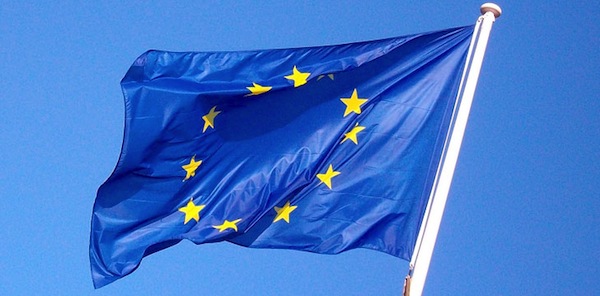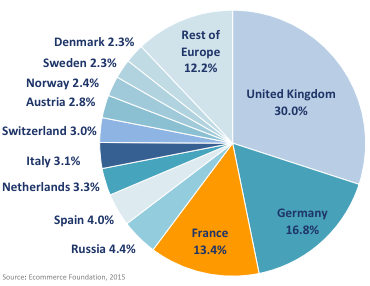E-commerce is Growing and So Should You
Nordic countries are known as pioneers when it comes to the popularity of online purchasing. Given the historically strong economic relations and pre-existing distribution networks between Germany and Scandinavia, this makes it a highly lucrative region for German e-commerce operators to focus their efforts on.
Norway, Sweden, Denmark, Finland — all are countries equipped with high purchasing power and a propensity for imports. Imports as a share have grown steadily in tandem with total online sales with no sign of slowing down. Depending on the country, in 2014 the share of imports in online sales was as high as 36%.
Especially now that the European Commission has set the standardization of taxation and elimination of barriers to e-commerce as its goal, forward-looking businesses should be prepared to expand their operations and conquer new territories

As Andrus Ansip (European Commission Vice-President for the Digital Single Market) has said:
”Let us do away with all those fences and walls that block us online. People must be able to freely go across-borders online just as they do offline. Innovative businesses must be helped to grow across the EU, not remain locked into their home market”
Scandinavian consumer behavior
What makes the Nordic countries an especially attractive region for the expansion of e-commerce is their near-universal prevalence of internet use. While the European average is 75%, Nordic countries can boast an internet use rate of 94% for their citizens.
An even bigger factor is the high purchasing power and consumer behavior of Scandinavians — with money to spend, they tend to display a high willingness and preparedness to buy from abroad, even overseas, if it means getting a better or cheaper product.
E-commerce from outside of a country’s borders:
| Country | 2012 | 2013 | 2014 |
|---|---|---|---|
| EU28 | 11% | 12% | 15% |
| Austria | 35% | 39% | 40% |
| Belgium | 25% | 28% | 34% |
| Bulgaria | 4% | 6% | 7% |
| Croatia | 6% | 7% | 8% |
| Cyprus | 19% | 21% | 24% |
| Czech Republic | 5% | 7% | 7% |
| Denmark | 29% | 32% | 36% |
| Estonia | 11% | 13% | 22% |
| Finland | 30% | 32% | 36% |
| France | 17% | 18% | 21% |
| Germany | 9% | 11% | 12% |
| Sweden | 19% | 23% | 22% |
| Norway | 30% | 27% | 33% |
Source: European B2C E-commerce Report 2015
Are you price competitive? Expand into Scandinavia
Although not the most populous markets when examined individually, taken as a whole Scandinavian countries present a tremendous opportunity for expansion for many German businesses — there’s a lot of untapped potential with a low barrier to entry and little competition in many fields, especially if competitive pricing is your business strategy.
High purchasing power doesn’t imply indiscriminate buying. On the contrary, for price-conscious Nordics, careful comparison is a deeply ingrained characteristic of consumer behavior. Far from impulsive buyers, 7 out of 10 Nordic consumers report checking prices from several competitors before arriving at a final purchasing decision. Furthermore, in the popular imagination, German businesses are widely associated with both low prices and high quality — an enviable combination, to be sure. When you add the ease of e-commerce into the mix, German businesses are well-poised to profitably turn this unique “brand reputation” into a competitive advantage that’s not easily mimicked by rivals
Expanding e-commerce: Why Scandinavia and not the UK?
Although Britain can claim roughly a third of all intra-European B2C (business-to-consumer) e-commerce, the higher level of competition this also implies is a considerable barrier to entry and makes the British e-commerce market a tough playing field altogether. By comparison, when targeting the Nordic countries, search engine optimization and online marketing requires the investment of considerably fewer resources — for example, organic traffic from search engines is much easier to generate even if your website hasn’t yet established high reliability. One of the reasons for this is that a large part of your competitors sell to Scandinavia only through websites that are in English, resulting in an inevitable loss of potential customers.

When considering expansion into Scandinavia, you should take into account the fact that search engine optimization is a time-consuming process — success won’t be achieved in just a few weeks. You should therefore begin localization and optimization immediately once your distribution is secure.
The challenges of B2C marketing in Scandinavia — E-commerce localization and targeted advertising
In addition to questions related to taxation, one of the main challenges of e-commerce expansion into Scandinavia is the localization of online marketing. Locally-based competitors usually have a more intimate understanding of their business environment to start with and therefore enjoy a competitive advantage in tailoring their content and advertising to suit local expectations. For example, cultural differences in customer demands are noticeable when it comes to payment method, price, delivery time, selection etc. Knowing how to tap into these idiosyncrasies and which aspects to emphasize in your marketing campaign will even the playing field in your favor. This is what localization is all about.
Localization will also help you more effectively target your advertising, whether this be according to geographic location or customer demographics. For instance, it might not be optimal to focus only on capital cities when there’s plenty of untapped demand in “peripheral” areas too. Relevant customer demographics might vary both within and between countries, too. In Sweden, for instance, online customers are considerably younger on average than in Norway, where 30-45 year olds are the most enthusiastic consumer segment.
By taking all these factors into account, proper e-commerce localization will help you gain a foothold in the Scandinavian market.
Maximize sales through localization and content optimization
A large part of Scandinavian consumers still prefer to shop in their own language. Translation and localization is therefore vital when you aim to maximize sales in these countries. Moreover, when content is optimized not only with customers but also with search engines in mind, you will undoubtedly save from future expenses.
If you are interested in website localization or need help with the tailoring your campaign to suit Scandinavian expectations, don’t hesitate to contact us.
If you found this article useful, remember to share it to others on social media. Thanks.


